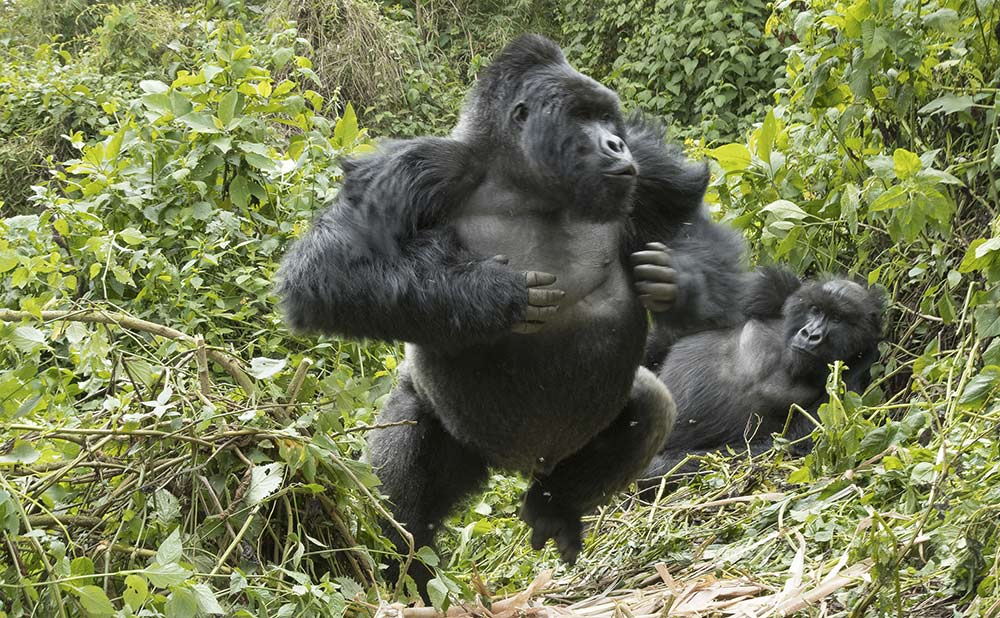Are Gorillas Dangerous?
Are Gorillas Dangerous?: Many travelers who intend to go on a gorilla trekking safari in Africa typically have a lot of questions, such as if gorillas are hazardous and what is required to see them, among many others. Despite their enormous appearance, gorillas—especially mountain gorillas, who are found exclusively in Rwanda, Uganda, and the Democratic Republic of the Congo—are shy and incredibly friendly apes.
A very gentle ape species, mountain gorillas are found in the mountain slopes and heavily forested areas of the Virunga Conservation Area, which includes the Congo‘s Virunga National Park, Rwanda‘s Volcanoes National Park, and Uganda‘s Mgahinga Gorilla National Park. The highest concentration of mountain gorillas is still found in Uganda’s Bwindi Impenetrable National Park.

The mountain gorillas are untamed creatures. However, because they have 98% of the same DNA as humans, they can act and engage with all of the many emotions that people have. Gorillas bond, love, care for their loved ones, are protective, and undoubtedly have the capacity for wrath, just like people. All human emotions, including pain, heartbreak, sadness, joy, and melancholy, are also experienced by gorillas.
When and how do gorillas pose a threat?
As was already noted, despite their enormous size, gorillas are a relatively quiet and gentle ape species. Poor treatment or interactions with the gorillas are the cause of their aggression and consequent danger.
When gorillas perceive that they are in danger, they act defensive and endanger either humans or other people or animals, such as other gorillas. Humans pose a threat to gorillas by using flash photography, approaching them too closely—say, closer than the advised 7 meters—staring them in the eyes, touching their young, and making clumsy movements and noises that the gorillas misinterpret. However, they will initially give off warning signals, such as yelling, hooting, banging their chests, stamping their feet on the ground, shifting on their hind legs, and grunting, when they feel threatened. The gorillas have the option to attack or not, depending on the threat’s actions.
When they physically attack their threat, gorillas can be dangerous. In order to accomplish this, they viciously bite, scratch, fracture ribs, and lash their opponent or threat, such as tourists that disregard the norms and regulations when gorilla trekking. In certain heavily forested national parks, they can even drag them very violently while carrying a ton of deadly crawlies. There have been cases where gorillas have killed people, but rarely with habituated gorillas that visitors visit. This largely applies to the poachers of those untamed and untamed gorillas.
However, because they are constantly in contact with one another, gorillas pose the greatest threat to themselves. Silverbacks can be quite harmful to one another when they are vying for control of a certain gorilla family since they stand to lose a great deal if they don’t fight to the best of their abilities. They sustain physical wounds from this battle, which occasionally lead to death.
When silverbacks choose to split off from the main gorilla family, they can only do so after defeating the dominant silverback in a fierce battle.
Additionally, because only the dominant silverback has the right to mate with all of the female gorillas in their family, dominant silverbacks occasionally fight with other male silverbacks when they are pursuing them.
In summary, visitors should be aware that gorillas are not harmful creatures, but they will become defensive if they feel threatened. Therefore, it is advised that visitors avoid the gorillas, which can only be accomplished by closely adhering to the laws and regulations.
Travelers are advised to abide by the following laws and regulations when gorilla trekking in order to prevent the gorillas’ wrath:
Keep your distance from the gorillas at 7 meters. This is so that the gorillas won’t feel frightened and become hostile, endangering the tourists in the process. It is also recommended that visitors avoid close contact with the gorillas and always remain in their groups.
Never, ever touch the gorillas. Although gorillas have been tamed for tourist visits, visitors are told that they are still wild animals. Because the dominant silverback is more protective and guards the young gorillas with extreme vigilance, travelers are especially advised not to touch the young. Travelers would run the risk of being assaulted if they attempted to touch them.
When photographing the gorillas, avoid using flash cameras. They become anxious, uneasy, and defensive as a result of the flash light, and they may attack the bearer.
Travelers on a gorilla trekking safari are guaranteed safety when interacting with the gorillas if they follow the aforementioned rules and standards. Furthermore, there are rangers who are well armed and educated to handle risky scenarios when gorilla trekking. You shouldn’t be put off by questions like “are gorillas dangerous?” when it comes to gorilla trekking in Africa. For assistance in organizing a secure gorilla trekking safari, get in contact with trustworthy travel companies.



